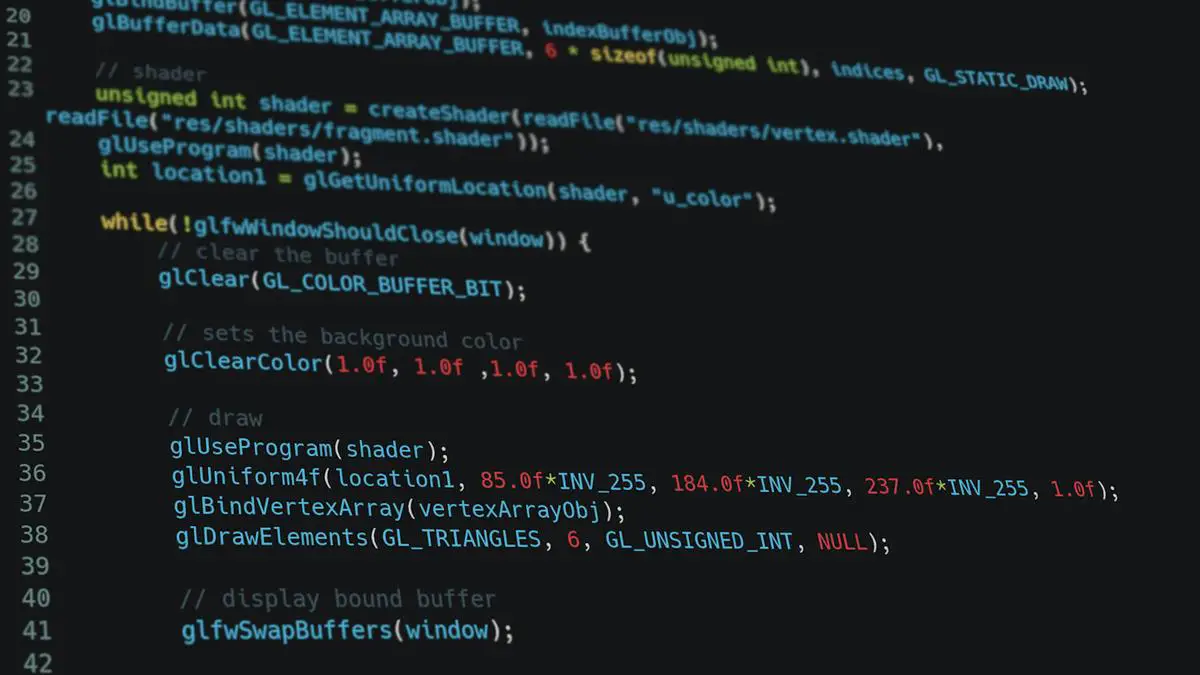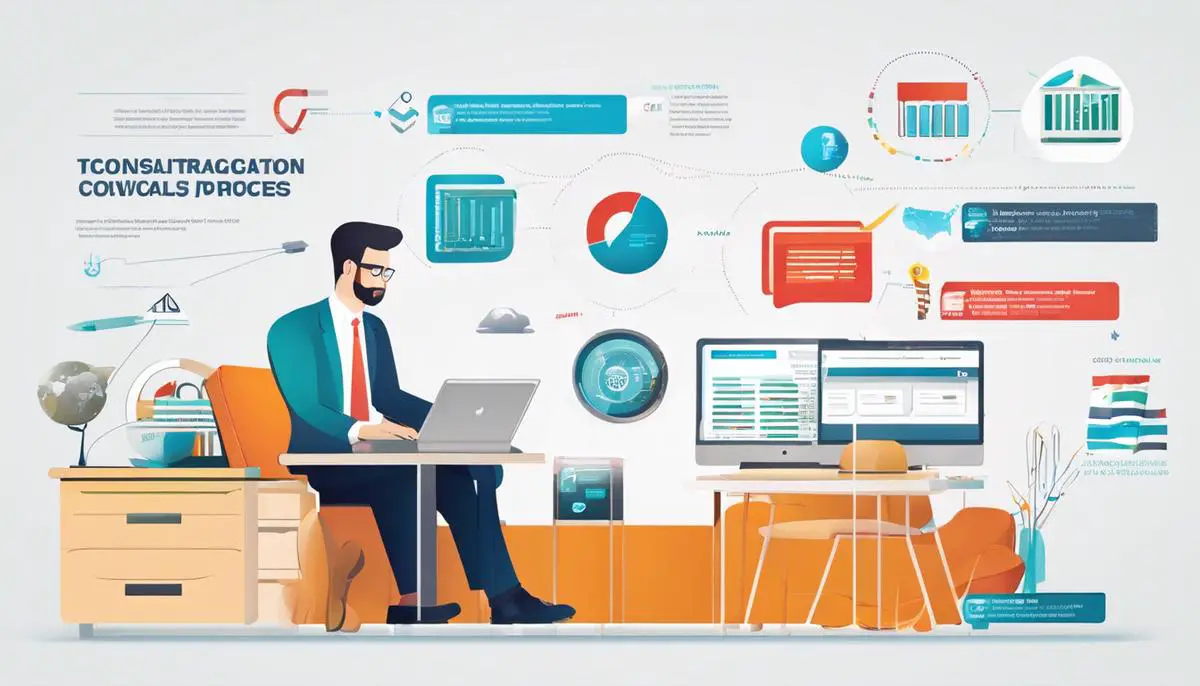Delving into the intricacies of machine code and high-level programming languages unveils a landscape rich with technical subtleties and the power of abstraction. At the heart of computer operation lies machine code, a fundamental language that orchestrates the symphony of bits processed by the Central Processing Unit (CPU). In stark contrast, high-level languages offer a sanctuary of readability and user-friendliness, bridging the gulf between human cognitive models and machine understanding. As we embark on a comprehensive exploration of the transformation from the elemental to the elaborate, we equip ourselves with tools designed to decode the enigmatic binary and reveal the architecture of underlying algorithms, paving the way for a greater mastery in the realm of code translation and decompilation.
Fundamentals of Machine Code and High-Level Languages
Decoding the Language of Machines: Understanding the Power of Machine Code
In the vast expanse of technology, there’s a persistent question that echoes in the minds of the tech-savvy: What really differentiates machine code from high-level programming languages? Let’s dive into the binary world and cut through the complexity with precision.
Envision machine code as the raw, elemental language your computer’s hardware speaks fluently. Every command executed, every task performed, traces back to a sequence of 0s and 1s. Machine code, also known as machine language, is binary instructions that the processor understands without any need for translation. It’s the most fundamental level of code, crafted to communicate directly with the electronic pulses of the processor.
On the flip side, high-level programming languages like Python, Java, or C++ have a different narrative. They are the diplomats of the coding world, designed to be understood by humans. These languages are abstracted far above the nitty-gritty binary of machine code, making them more accessible and intuitive for developers to handle complex tasks. They use human-understandable syntax and are versatile, ranging from developing applications to solving intricate scientific computations.
Here’s the punchline: machine code is all about efficiency and speed. It’s tailored to the hardware, so it’s lightning fast, but writing in it is a lengthy and error-prone process for humans. High-level languages, though slower due to their need to be translated back into machine code for the computer to execute, offer the luxury of rapid development and maintenance, which is a big win for productivity.
The brilliance of machine code shines when optimizing performance is a top priority and resources are limited. Maybe you’re building a firmware for an embedded system with tight memory constraints or squeezing extra performance out of a high-throughput server system; machine code allows you to tweak every bit to perfection.
On the other hand, high-level languages are the go-to for just about everything else, from everyday apps to massive cloud-based services. They enable developers to solve problems with technology in less time, with fewer bugs, and with far less hair-pulling.
While machine code serves as the foundation, high-level languages are the cityscapes built upon it, towering with logical architectures and intricate roads of algorithms. Each has its domain, its strengths, and its advocates. Embracing this duality, and knowing when to harness the raw power of machine code or the swift versatility of high-level languages, remains a key trait of tech enthusiasts who always surge ahead, ready to solve the next big problem with the best tools at hand.

Tools for Code Translation and Decompilation
Title:Unraveling the Complexity: Top Tools for Machine Code Decompilation
Machine code is the bedrock of software execution, but humans don’t natively speak in zeros and ones. High-level languages are our go-to for creating complex software without getting tangled in the machine’s strict syntax. But what happens when you need to dive back into the machine code to debug, analyze or recover a lost source code? This is where machine code decompilation comes into play.
Decompilation is the reverse process of compilation: it transforms machine code back into a human-readable format. It’s not an exact science, with many challenges due to the lack of variable names, comments, and data types. But despite these challenges, some tools excel at decompiling machine code.
IDA Pro
The Interactive Disassembler, or IDA Pro, is a multipurpose reverse engineering tool with powerful decompilation capabilities. It’s a favorite in the security industry for its robust disassembly of binary code and comprehensive support of processors. With a plugin called Hex-Rays, it turns into a formidable decompiler, translating executable programs into assembly and high-level code. This aids greatly in the understanding of how compiled applications work.
Ghidra
Ghidra is a reverse engineering tool released by the National Security Agency (NSA) and boasts impressive decompilation features. Its interactive environment allows for dynamic analysis of binary programs. While Ghidra didn’t start with native decompilation functionality, it quickly matched the performance of other tools and offers an open-source alternative for the reverse engineering community. With a rich API and a growing community, Ghidra’s decompiler module can handle a variety of platforms, making it a versatile tool for the task.
Radare2 and Cutter
Radare2, often paired with its GUI version Cutter, is an open-source reverse engineering toolkit. Cutter provides a more user-friendly interface to Radare2’s capabilities, including its decompilation features. Cutter integrates the popular retdec decompiler for a range of architectures and has seen steady growth in user-base thanks to its open-source model and active development.
RetDec
RetDec, short for Retargetable Decompiler, is a standalone decompiler that can also be used within other frameworks, such as IDA Pro and Radare2. It targets multiple architectures and leverages a compilation in the reverse methodology, supporting decompilation of binary files into C code. It might not always produce perfect high-level code, but it provides a solid starting point for understanding what a program does.
The value of a competent decompiler can’t be overstated. They’re essential for developers working in secure coding, software reverse engineering, and malware analysis. Decompilers like IDA Pro, Ghidra, Radare2/Cutter, and RetDec provide the bridge from raw, unintelligible machine code to human-readable code that can range from assembly to the ideal, high-level representation. And in a world of increasing cyber threat landscapes, these tools are not just useful but critical in responding to and understanding attacks on software systems.
Arming oneself with a good decompiler means gaining the foresight to troubleshoot, dissect, and learn from compiled applications. It’s a tough job being a digital detective in the dense forest of machine code, but with the right tools, the task becomes a challenging puzzle waiting to be solved. Whether you’re reverse engineering for security, recovering lost source code, or simply satisfying a curiosity for how applications operate beneath the surface, these leading tools in machine code decompilation are your go-to resources. Embrace them, master them, and unlock the full potential of binary analysis.

Photo by krishna2803 on Unsplash
Challenges in Machine Code Translation
Machine code translation, or the process of interpreting the raw instructions that a computer’s CPU understands, stands at the core of the software world’s functionality. Yet, it is fraught with complexity. This intricacy arises from several factors that make machine code translation a challenging task for both humans and automated tools.
Firstly, machine code is inherently low-level. It operates close to the hardware, which means it’s optimized for machine efficiency, and not for human readability. Each CPU architecture has its unique machine code instruction set, which requires specific knowledge and expertise to understand and translate effectively.
Secondly, machine code lacks the context and abstractions present in high-level languages. While high-level languages use variables, structures, and other abstractions to convey meaning in a human-readable way, machine code consists of binary or hexadecimal instructions that offer no such context. This absence of structure means that a machine code translator must infer meaning from a series of seemingly arbitrary numbers.
Furthermore, the translation process involves converting these low-level instructions into a form that preserves the original program’s logic and functionality. However, machine code often contains optimized, modified, or obfuscated instructions that don’t easily map back to high-level constructs, making translation a puzzle that requires attention to detail and profound understanding.
Additionally, consider that machine code does not maintain any of the comments or descriptive naming found in high-level code. This results in a lack of explanatory notes that could guide the translation process. Comments, often seen as superfluous in machine-executed code, play a significant role in understanding the intention behind certain chunks of code when translating back to a higher level.
Translation requires not just a syntactic conversion but also a semantic understanding. A translator must recognize patterns and algorithms from the bare machine code, deduce the purpose of subroutines, and identify data structures from their usage patterns. Since machines operate on logic rather than intent, much of the context that human programmers would leverage is lost in translation.
When it comes to automating machine code translation, the problem multiplies. Automated tools must use sophisticated algorithms to attempt to recreate the higher-level structure and logic of the original program, piecing together the puzzle without the aid of human intuition. While decompilers and reverse engineering tools have become increasingly sophisticated, they are far from perfect.
The complexity of machine code translation is also exacerbated by the sheer variety of machine code dialects, each corresponding to different processor types and architectures. A translation tool or method suitable for one type of machine code might be entirely inappropriate for another, necessitating specialized knowledge and tools for each platform.
Enhancements in artificial intelligence and machine learning may eventually simplify machine code translation, but for now, it remains a domain where analytical prowess, patience, and a deep understanding of computer architecture reign supreme. As technology continues to evolve, enthusiasts and professionals in the field will continue to grapple with the complex world of machine code translation, ensuring the underlying machinery of our digital world runs smoothly.

Accuracy and Limitations of Translated Code
When we talk about the accuracy of translated high-level code, we’re essentially tackling the nuances of translating human-readable code into a form that’s palatable for machines, and vice versa. The golden question is: How close can we get to the original source code once it has been through the compilation and subsequent decompilation cycle?
First, let’s appreciate the role of compilers. Compilers are a bridge between high-level languages and machine code, taking programmer-friendly instructions and turning them into low-level commands a CPU can understand. This process is intricate and detail-oriented, irrevocably altering the code structure to prioritize efficiency.
Turning our attention towards accuracy in this compiled code, one critical aspect is optimization. Compilers don’t just translate; they transform. They optimize the code to run faster or take up less space. Such optimizations can make the decompiled code look quite different from the original source. Remember, a compiler’s objective is performance, not maintaining human-readable aesthetics.
Another key factor affecting accuracy is the loss of metadata. High-level code contains a wealth of information: variable names, data structure definitions, comments, and more. This metadata is invaluable for understanding code but is often discarded during compilation since it’s not necessary for execution. When reversing, decompilers attempt to infer this information, but it’s essentially a reconstruction rather than a recovery. The resulting code often lacks these helpful details, making it harder for humans to interpret.
Variables and functions also take a hit in the translation. What was once a meticulously named variable might become a cryptic representation, say ‘var_1’, after decompilation. This obfuscation is not because decompilers want to make life hard but because the original names are not preserved in machine code.
What about control structures? High-level languages often use constructs like loops and conditionals. While machine code does execute these structures, it doesn’t inherently understand them. Decompilers have the daunting task of analyzing machine code patterns to reconstruct these high-level constructs. The output can range from impressively accurate to barely recognizable, depending on numerous factors such as the complexity of the original code and the decompiler’s algorithms.
Here’s where the potential of AI comes into play. Advanced algorithms could significantly improve the accuracy of machine code translations. By ‘learning’ from vast datasets of code, AI could predict patterns and make educated guesses about lost metadata, potentially restoring a degree of readability to decompiled code. However, AI is not a silver bullet; it’s only as good as the patterns it’s trained on, and novel or complex code snippets could still confound even the most sophisticated AI.
In the end, the accuracy of translated high-level code depends on the complexity of the source code, the compiler optimizations, and the capabilities of decompilers. While tools like IDA Pro and Ghidra are incredibly powerful, they work within the limitations imposed by the nature of machine code. As technology advances, so will these translation capabilities, but a perfect one-to-one translation remains a challenge. For now, tech enthusiasts should continue honing their reverse engineering skills to bridge the gaps that technology currently can’t.

Use Cases of Code Translation
Demystifying the Need for Machine Code to High-Level Language Translation
Machine code, while blazingly fast and direct, often feels like an ancient script to modern developers. On the other end, high-level languages charm with their readability and approachability. But let’s dissect when to unfurl the ladder from these human-friendly highlands to the binary depths.
Let’s start by addressing interoperability. A world running on countless platforms needs software muscles that flex across various systems. Machine code to high-level language translation becomes paramount when there’s a need to migrate legacy systems to newer, more maintainable frameworks without reinventing the wheel. Think of translating vintage video games into Java or C# to preserve digital heritage while reaching broader audiences with contemporary platforms.
Reverse engineering is another arena where translation swings into action. Whether it’s peeling back the layers on a competitor’s product to understand their secret sauce or unwrapping malicious code to design robust defenses, one must translate zeroes and ones into a comprehensible form. This layered approach allows engineers to spot vulnerabilities, reconstruct old lost source code, and even assure legal compliance by dissecting third-party binaries when documentation is as scarce as a polite comment in anonymous internet forums.
When discussing enhancements, sometimes translated code reveals performance bottlenecks. Translating machine code identifies inefficiencies invisible among higher-level abstractions. By pinpointing these areas, one can tweak algorithms or rethink approaches at the high-level to optimize both performance and resource consumption.
What about educational purposes? There’s a profound difference in understanding a concept and seeing it in action. By translating machine code back to high-level languages, educators and learners can study how theoretical programming constructs manifest in the raw logic that CPUs understand. It’s a beneficial approach for those aiming to grasp the nitty-gritty of computer science and software engineering.
Furthermore, platform compatibility is not just about operating systems, but hardware too. The translation becomes crucial when adapting software to run efficiently on different processor architectures. It helps preserve the original software’s intention while ensuring it runs smoothly on anything from a supercomputer to an IoT device.
Inherited codebases are like family recipes passed down with missing steps. Translation aids in understanding and documenting such codebases which have been handed down through generations of programmers, sometimes with little to no comments or documentation. Making sense of these can be akin to deciphering ancient scrolls, yet it’s fundamental for ongoing maintenance and feature expansion.
Lastly, globalization demands language versatility. Translated machine code can create multiple high-level language versions of proprietary software. This step caters to various developer communities around the globe and diversifies the ecosystem, promoting inclusivity in the tech space.
In an era where technology evolves faster than ever, the need for translation from machine code to high-level languages underscores the balance between the relentless march of progress and the need to retain, comprehend, and enhance what has already been built. Automated or manual, this translation is about ensuring the software’s longevity, portability, and adaptability, facilitating a fluid and dynamic dialogue between past innovations and future visions. As technology forges ahead, mastering the art of translation between machine code and high-level languages remains an essential skill in the developer’s toolkit, one that boldly bridges the chasm between raw performance and human ingenuity.

The Future of Code Translation Technology
### The Upshot on Automated Code Translation and Decompilation: What’s Next?
In the dynamic realm of coding, the future teems with potential, specifically in the domain of code translation and decompilation. As tech enthusiasts, the burning question is: Where do we go from here?
The march of progress points towards automation as an increasingly central player in this arena. Traditional manual translation and comprehension of machine code can be cumbersome and time-intensive. But tech advancements promise a seismic shift in how efficiently and effectively this can be done.
Artificial Intelligence (AI) stands at the forefront of this revolution. Current decompilation tools already show AI’s nascent potential, but the anticipation buzzes around AI’s continued evolution. Advanced algorithms could automate the understanding of low-level code, predict patterns, and even repurpose machine code with an unprecedented level of accuracy.
One pivotal breakthrough to watch is the development of universal translators for code, aiming to standardize translation across CPU architectures. This universalization process could potentially bridge the gap between different programming paradigms and machine languages, making cross-platform development and maintenance a breeze.
However, let’s not get ahead of ourselves; several hurdles loom. The complexity of different programming languages and the exquisite precision with which they must be handled in translation is still a formidable challenge. Plus, preserving the original intent of the developer—a nuanced and often subjective matter—is no small feat for cold, logical AI.
Security likewise commands attention. Decompilers that can seamlessly navigate the labyrinth of modern code can be double-edged swords. While they offer significant boons in terms of analyzing and understanding attacks, they also unlock tools for those with malicious intent. Thus, future advancements must also prioritize robust protective measures.
The role of communities in this evolution cannot be understated. Collaboration in the open-source ecosystem has and will continue to feed the accelerated growth of decompilation and translation tools. Shared knowledge and collective problem-solving are the jet fuel propelling forward progress.
Cutting-edge research in machine learning could also ingrain context awareness in AI decompilers, allowing them to not only translate but also to comprehend code at a conceptual level—echoing human-like understanding.
Last but not least, code translation isn’t just a matter of syntax swopping. It’s about ensuring the soul of the software—its functionality and performance—remains intact. For devs, the capacity to translate across environments while optimizing for performance will be game-changing.
Looking beyond the horizon, one envisions a future with seamless code conversion, where intricate machine code is scrutinized and re-worked with ease, and legacy systems merge into the new age without losing a byte of their essence. Through automation, accuracy, and AI, the path ahead for code translation and decompilation is one set to redefine the limits of programming.

The pursuit of translating machine code to high-level languages is a testament to the ceaseless quest for understanding and innovation that drives the technology sector. Amidst the vast sea of binary instructions, lies the potential to unravel the secrets locked within, offering a glimpse into the past and a vision for the future. As the field marches towards a horizon filled with intelligent decompilers and advanced computational methods, we stand on the cusp of a new epoch where translation is not merely a task, but a conduit to limitless discovery and the reclamation of knowledge once thought obfuscated. The transformative power of machine code translation continues to shape our digital world, crafting a legacy of ingenuity and endless possibilities.
